Honglak Lee
University of Michigan, Ann Arbor
Similarity of Neural Network Representations Revisited
May 14, 2019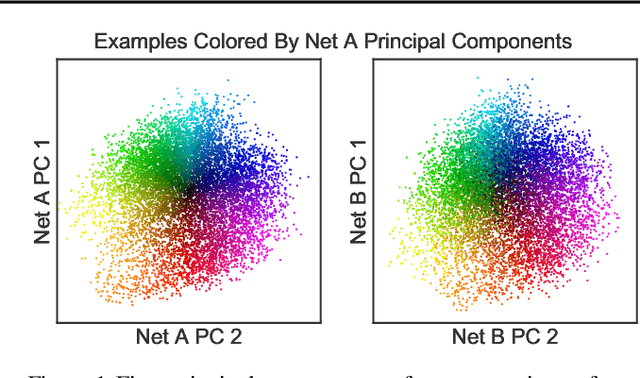
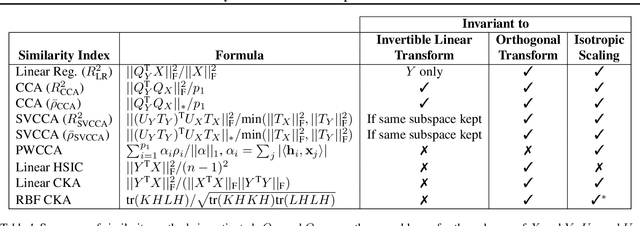
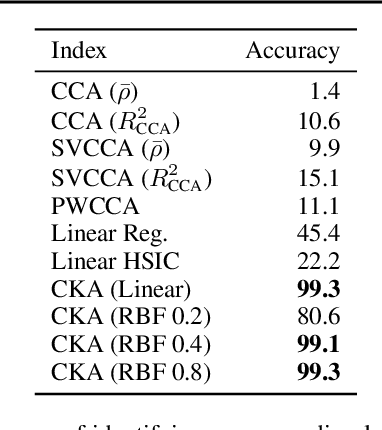
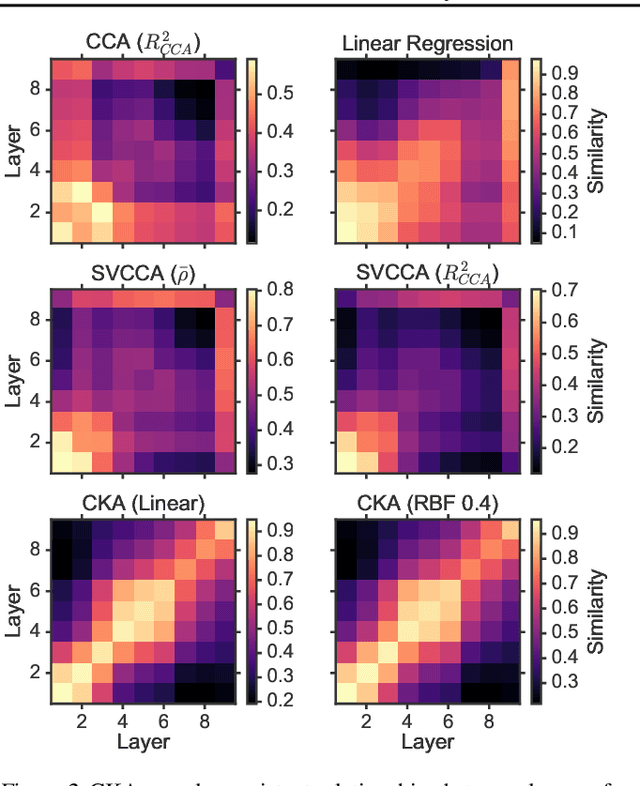
Abstract:Recent work has sought to understand the behavior of neural networks by comparing representations between layers and between different trained models. We examine methods for comparing neural network representations based on canonical correlation analysis (CCA). We show that CCA belongs to a family of statistics for measuring multivariate similarity, but that neither CCA nor any other statistic that is invariant to invertible linear transformation can measure meaningful similarities between representations of higher dimension than the number of data points. We introduce a similarity index that measures the relationship between representational similarity matrices and does not suffer from this limitation. This similarity index is equivalent to centered kernel alignment (CKA) and is also closely connected to CCA. Unlike CCA, CKA can reliably identify correspondences between representations in networks trained from different initializations.
Incremental Learning with Unlabeled Data in the Wild
Mar 29, 2019
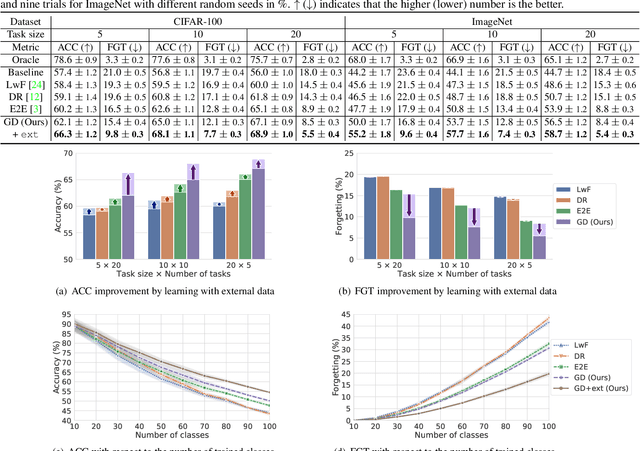
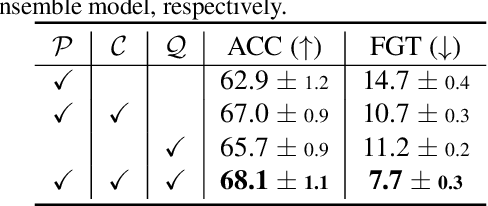
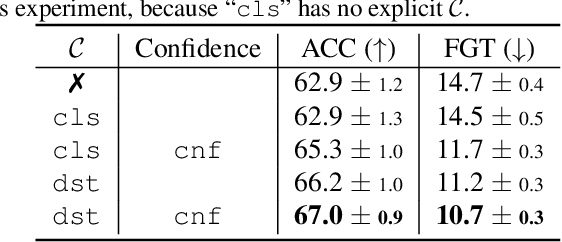
Abstract:Deep neural networks are known to suffer from catastrophic forgetting in class-incremental learning, where the performance on previous tasks drastically degrades when learning a new task. To alleviate this effect, we propose to leverage a continuous and large stream of unlabeled data in the wild. In particular, to leverage such transient external data effectively, we design a novel class-incremental learning scheme with (a) a new distillation loss, termed global distillation, (b) a learning strategy to avoid overfitting to the most recent task, and (c) a sampling strategy for the desired external data. Our experimental results on various datasets, including CIFAR and ImageNet, demonstrate the superiority of the proposed methods over prior methods, particularly when a stream of unlabeled data is accessible: we achieve up to 9.3% of relative performance improvement compared to the state-of-the-art method.
Robust Inference via Generative Classifiers for Handling Noisy Labels
Jan 31, 2019



Abstract:Large-scale datasets may contain significant proportions of noisy (incorrect) class labels, and it is well-known that modern deep neural networks (DNNs) poorly generalize from such noisy training datasets. To mitigate the issue, we propose a novel inference method, termed Robust Generative classifier (RoG), applicable to any discriminative (e.g., softmax) neural classifier pre-trained on noisy datasets. In particular, we induce a generative classifier on top of hidden feature spaces of the pre-trained DNNs, for obtaining a more robust decision boundary. By estimating the parameters of generative classifier using the minimum covariance determinant estimator, we significantly improve the classification accuracy with neither re-training of the deep model nor changing its architectures. With the assumption of Gaussian distribution for features, we prove that RoG generalizes better than baselines under noisy labels. Finally, we propose the ensemble version of RoG to improve its performance by investigating the layer-wise characteristics of DNNs. Our extensive experimental results demonstrate the superiority of RoG given different learning models optimized by several training techniques to handle diverse scenarios of noisy labels.
Diversity-Sensitive Conditional Generative Adversarial Networks
Jan 25, 2019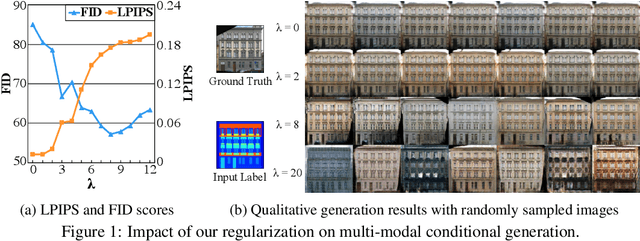
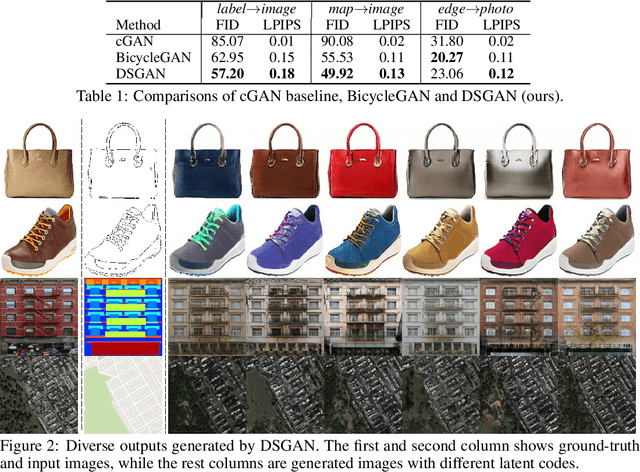
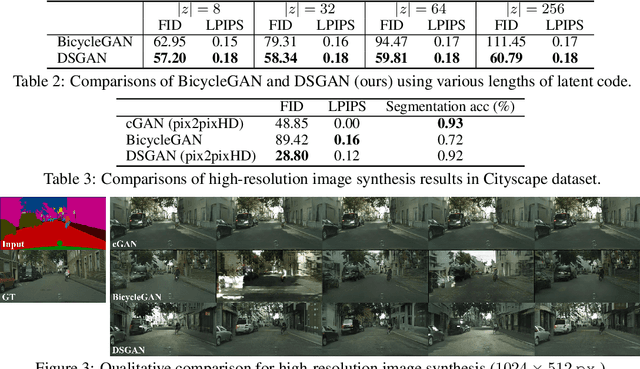

Abstract:We propose a simple yet highly effective method that addresses the mode-collapse problem in the Conditional Generative Adversarial Network (cGAN). Although conditional distributions are multi-modal (i.e., having many modes) in practice, most cGAN approaches tend to learn an overly simplified distribution where an input is always mapped to a single output regardless of variations in latent code. To address such issue, we propose to explicitly regularize the generator to produce diverse outputs depending on latent codes. The proposed regularization is simple, general, and can be easily integrated into most conditional GAN objectives. Additionally, explicit regularization on generator allows our method to control a balance between visual quality and diversity. We demonstrate the effectiveness of our method on three conditional generation tasks: image-to-image translation, image inpainting, and future video prediction. We show that simple addition of our regularization to existing models leads to surprisingly diverse generations, substantially outperforming the previous approaches for multi-modal conditional generation specifically designed in each individual task.
Learning Latent Dynamics for Planning from Pixels
Dec 03, 2018


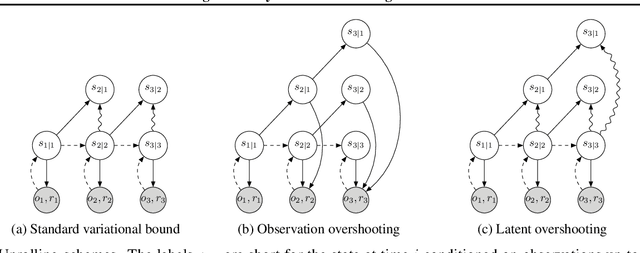
Abstract:Planning has been very successful for control tasks with known environment dynamics. To leverage planning in unknown environments, the agent needs to learn the dynamics from interactions with the world. However, learning dynamics models that are accurate enough for planning has been a long-standing challenge, especially in image-based domains. We propose the Deep Planning Network (PlaNet), a purely model-based agent that learns the environment dynamics from pixels and chooses actions through online planning in latent space. To achieve high performance, the dynamics model must accurately predict the rewards ahead for multiple time steps. We approach this problem using a latent dynamics model with both deterministic and stochastic transition function and a generalized variational inference objective that we name latent overshooting. Using only pixel observations, our agent solves continuous control tasks with contact dynamics, partial observability, and sparse rewards. PlaNet uses significantly fewer episodes and reaches final performance close to and sometimes higher than top model-free algorithms.
Generative Adversarial Self-Imitation Learning
Dec 03, 2018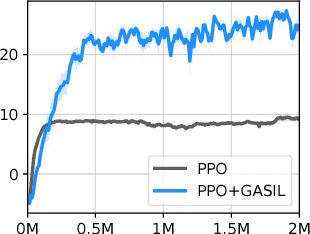
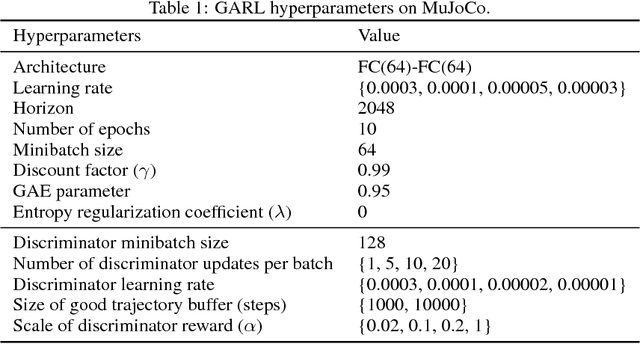
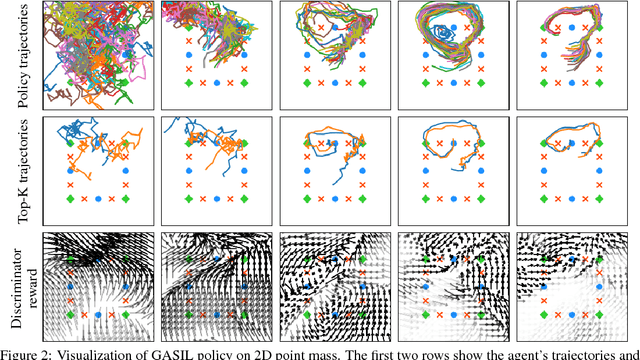
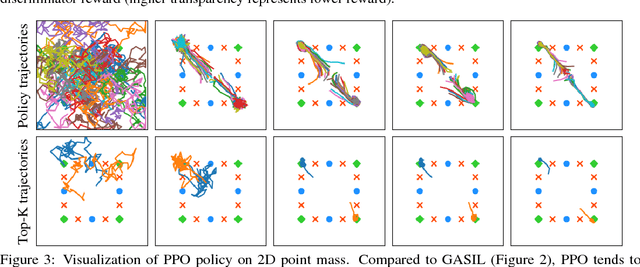
Abstract:This paper explores a simple regularizer for reinforcement learning by proposing Generative Adversarial Self-Imitation Learning (GASIL), which encourages the agent to imitate past good trajectories via generative adversarial imitation learning framework. Instead of directly maximizing rewards, GASIL focuses on reproducing past good trajectories, which can potentially make long-term credit assignment easier when rewards are sparse and delayed. GASIL can be easily combined with any policy gradient objective by using GASIL as a learned shaped reward function. Our experimental results show that GASIL improves the performance of proximal policy optimization on 2D Point Mass and MuJoCo environments with delayed reward and stochastic dynamics.
Contingency-Aware Exploration in Reinforcement Learning
Nov 05, 2018

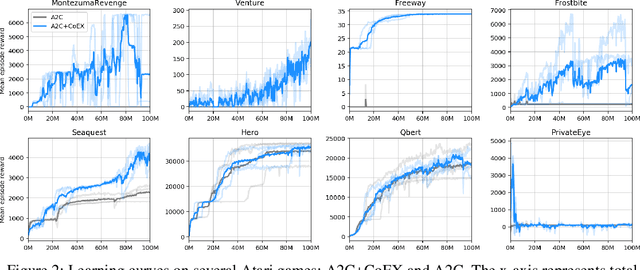
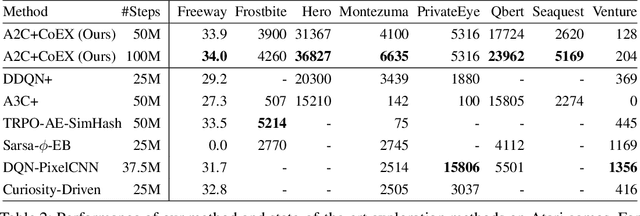
Abstract:This paper investigates whether learning contingency-awareness and controllable aspects of an environment can lead to better exploration in reinforcement learning. To investigate this question, we consider an instantiation of this hypothesis evaluated on the Arcade Learning Element (ALE). In this study, we develop an attentive dynamics model (ADM) that discovers controllable elements of the observations, which are often associated with the location of the character in Atari games. The ADM is trained in a self-supervised fashion to predict the actions taken by the agent. The learned contingency information is used as a part of the state representation for exploration purposes. We demonstrate that combining A2C with count-based exploration using our representation achieves impressive results on a set of notoriously challenging Atari games due to sparse rewards. For example, we report a state-of-the-art score of >6600 points on Montezuma's Revenge without using expert demonstrations, explicit high-level information (e.g., RAM states), or supervised data. Our experiments confirm that indeed contingency-awareness is an extremely powerful concept for tackling exploration problems in reinforcement learning and opens up interesting research questions for further investigations.
Content preserving text generation with attribute controls
Nov 03, 2018



Abstract:In this work, we address the problem of modifying textual attributes of sentences. Given an input sentence and a set of attribute labels, we attempt to generate sentences that are compatible with the conditioning information. To ensure that the model generates content compatible sentences, we introduce a reconstruction loss which interpolates between auto-encoding and back-translation loss components. We propose an adversarial loss to enforce generated samples to be attribute compatible and realistic. Through quantitative, qualitative and human evaluations we demonstrate that our model is capable of generating fluent sentences that better reflect the conditioning information compared to prior methods. We further demonstrate that the model is capable of simultaneously controlling multiple attributes.
Hierarchical Reinforcement Learning for Zero-shot Generalization with Subtask Dependencies
Nov 02, 2018
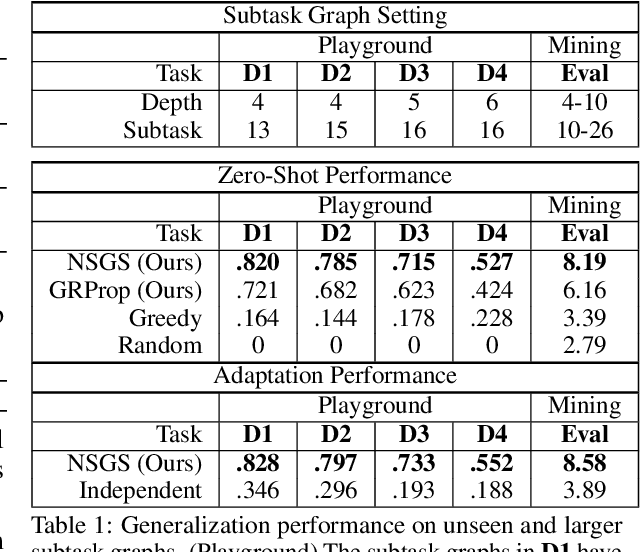
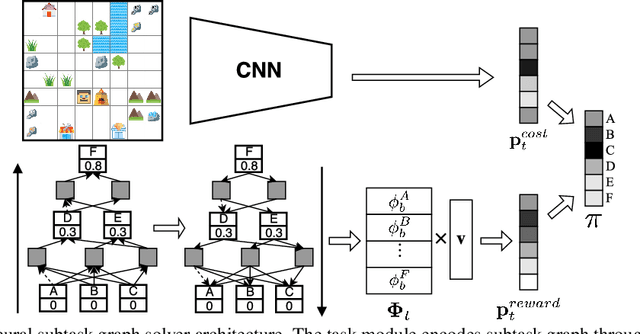
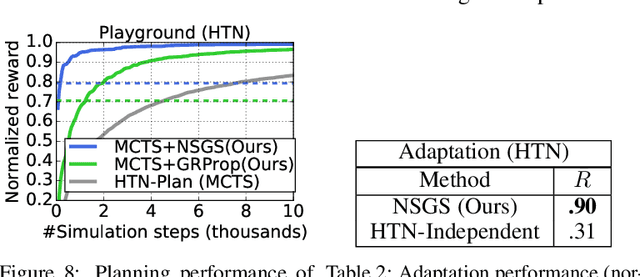
Abstract:We introduce a new RL problem where the agent is required to generalize to a previously-unseen environment characterized by a subtask graph which describes a set of subtasks and their dependencies. Unlike existing hierarchical multitask RL approaches that explicitly describe what the agent should do at a high level, our problem only describes properties of subtasks and relationships among them, which requires the agent to perform complex reasoning to find the optimal subtask to execute. To solve this problem, we propose a neural subtask graph solver (NSGS) which encodes the subtask graph using a recursive neural network embedding. To overcome the difficulty of training, we propose a novel non-parametric gradient-based policy, graph reward propagation, to pre-train our NSGS agent and further finetune it through actor-critic method. The experimental results on two 2D visual domains show that our agent can perform complex reasoning to find a near-optimal way of executing the subtask graph and generalize well to the unseen subtask graphs. In addition, we compare our agent with a Monte-Carlo tree search (MCTS) method showing that our method is much more efficient than MCTS, and the performance of NSGS can be further improved by combining it with MCTS.
A Simple Unified Framework for Detecting Out-of-Distribution Samples and Adversarial Attacks
Oct 27, 2018


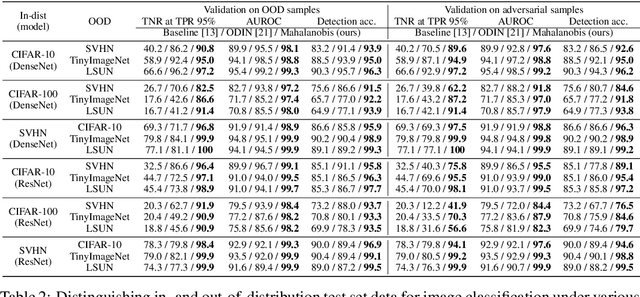
Abstract:Detecting test samples drawn sufficiently far away from the training distribution statistically or adversarially is a fundamental requirement for deploying a good classifier in many real-world machine learning applications. However, deep neural networks with the softmax classifier are known to produce highly overconfident posterior distributions even for such abnormal samples. In this paper, we propose a simple yet effective method for detecting any abnormal samples, which is applicable to any pre-trained softmax neural classifier. We obtain the class conditional Gaussian distributions with respect to (low- and upper-level) features of the deep models under Gaussian discriminant analysis, which result in a confidence score based on the Mahalanobis distance. While most prior methods have been evaluated for detecting either out-of-distribution or adversarial samples, but not both, the proposed method achieves the state-of-the-art performances for both cases in our experiments. Moreover, we found that our proposed method is more robust in harsh cases, e.g., when the training dataset has noisy labels or small number of samples. Finally, we show that the proposed method enjoys broader usage by applying it to class-incremental learning: whenever out-of-distribution samples are detected, our classification rule can incorporate new classes well without further training deep models.
 Add to Chrome
Add to Chrome Add to Firefox
Add to Firefox Add to Edge
Add to Edge